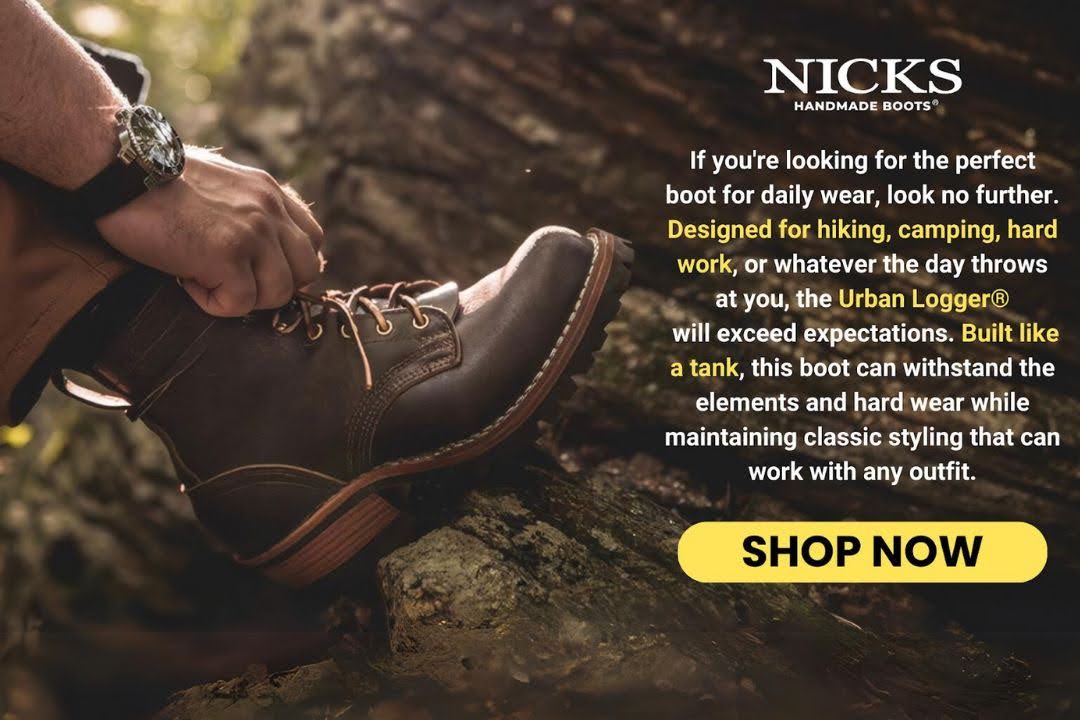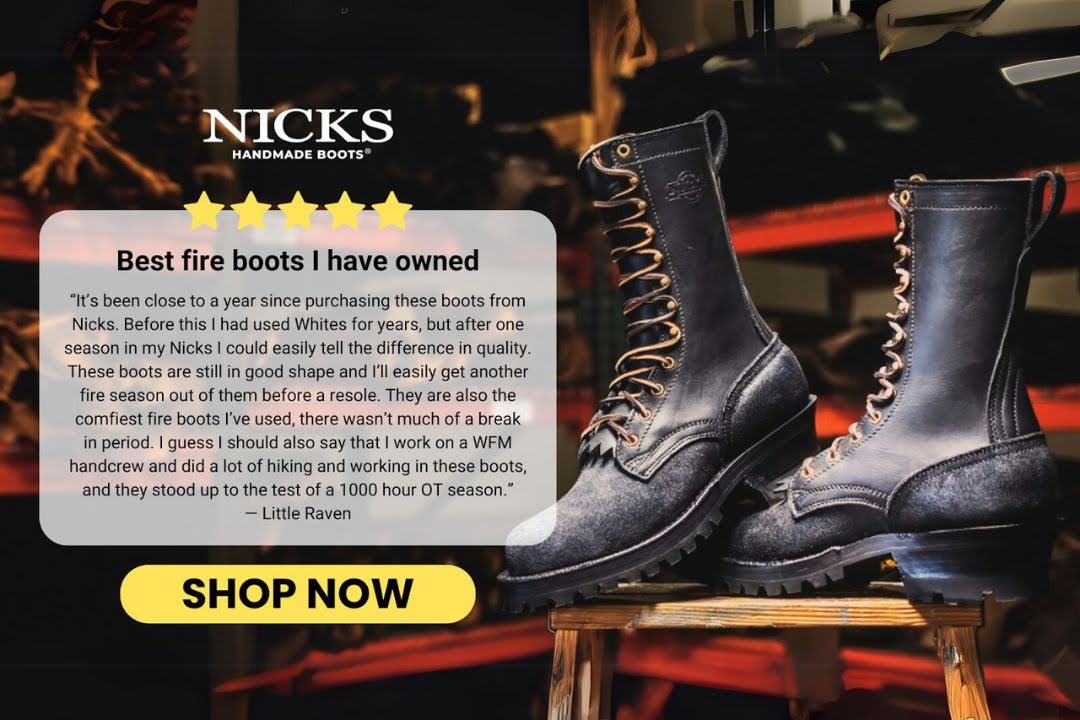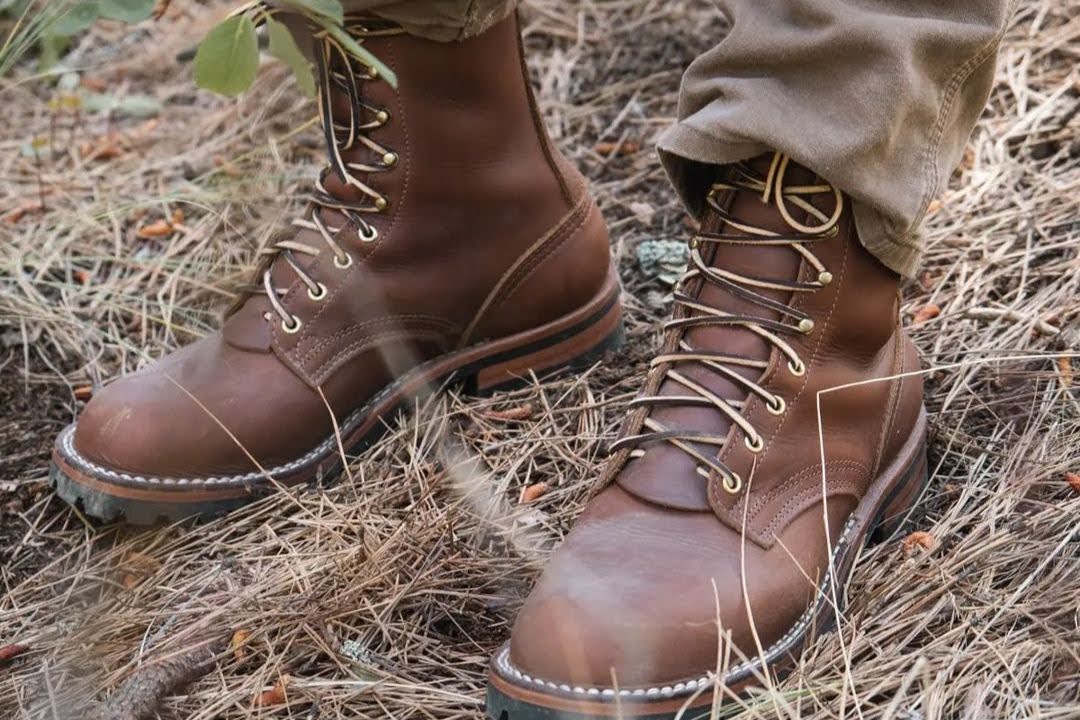Key Takeaways:
- Advanced Features: Look for boots with superior cushioning, arch support, and durable materials like leather or synthetic composites that can withstand the harshness of concrete.
- Proper Fit and Maintenance: Ensuring a proper fit and regular maintenance like cleaning and conditioning can significantly extend the life of your boots.
- Health and Comfort Benefits: Choosing the right boots not only protects your feet but also supports overall body health by reducing the impact on joints and improving stability on tough surfaces.
Nicks Boots is where superior craftsmanship and exceptional quality converge. As experts in high-quality footwear, we know that the right boots are essential for walking on tough surfaces like concrete. Our boots are engineered for maximum comfort, durability, and support, helping you move confidently in the right direction.
Walking on concrete all day can be extremely tough on both your feet and your footwear. The hard, unyielding surface can lead to foot fatigue, discomfort, and even long-term issues like joint pain if not addressed with the right type of boots. Choosing the ideal footwear is crucial for providing the necessary comfort and durability under such demanding conditions.
In this piece, we will highlight the importance of choosing the right boots for concrete to enhance your comfort and protect your long-term health. We'll detail the essential features to consider, such as cushioning, support, weather resistance, and durability. You'll discover our top recommendations for concrete-friendly boots, learn how to maintain them, and read testimonials from our satisfied customers.

Why It’s Important To Choose The Right Boots For Concrete
Impact On Body Mechanics
Walking on concrete surfaces can be harsh due to its unyielding nature. Unlike softer terrains, concrete does not absorb shock, causing each step you take to generate impact that travels up through your feet to your legs and spine. This constant pressure can lead to joint pain, spinal issues, and other chronic musculoskeletal problems. Our boots are designed with superior cushioning that helps absorb this shock, protecting your body from the harsh effects of concrete.
Longevity And Durability
Choosing boots that aren't designed for concrete can lead to quicker wear and tear. Concrete surfaces can be abrasive to footwear, leading to the degradation of materials that are not equipped to handle such harsh environments. Our boots use high-quality, durable materials that are specifically chosen for their ability to withstand long periods on concrete. This not only ensures your boots last longer but also maintains their protective and comfort features throughout their life.
Safety And Performance
On concrete surfaces, stability and grip are crucial for safety, especially in work environments where spills, moisture, or uneven surfaces may be encountered. Poorly suited boots can increase the risk of slips, trips, and falls. Our boots are crafted with advanced outsole technologies that provide excellent traction and grip, enhancing your stability and reducing the risk of accidents. This is essential not just for safety but also for maintaining high performance and efficiency during work or daily activities.
Psychological Comfort And Work Efficiency
Wearing the right boots can also influence your mental well-being and productivity. Comfortable, supportive footwear helps to reduce fatigue, allowing you to perform better and feel more focused and less distracted by discomfort. This psychological comfort translates into higher work efficiency and overall job satisfaction.
Step up your comfort and protect your feet with the right boots from Nicks Boots. Our selection is specifically designed for durability and support, ideal for anyone who spends long hours walking on concrete. Shop now and discover boots that blend comfort with resilience, ensuring you can tackle any hard surface with ease.
Key Features To Look For In Boots For Walking On Concrete
- Advanced Cushioning And Shock Absorption - One of the most crucial features for any boot designed for walking on concrete is superior cushioning. Our boots are equipped with advanced cushioning systems that absorb the shock that would otherwise be transferred to your feet and legs. This helps to minimize fatigue and protect your joints from the repetitive impact of walking on hard surfaces.
- High Durability Materials - The durability of your boots is paramount when regularly walking on abrasive surfaces like concrete. We use premium materials that resist wear and tear, ensuring that your boots not only last longer but also maintain their shape and protective features. Materials such as reinforced leather and synthetic composites are selected for their toughness and longevity.
- Ergonomic Support - Proper support is vital to prevent foot and ankle injuries and to maintain overall body alignment. Our boots offer structured support, including arch support and ankle stabilization, which are essential for anyone spending long hours on their feet. This support helps prevent common issues such as plantar fasciitis and ankle sprains.
- Slip-Resistant Outsoles - For safety, particularly in work environments where spills or slick surfaces are common, slip-resistant outsoles are a must. Our boots feature outsoles designed with patterns and materials that grip onto concrete, enhancing your stability and preventing falls.
- Breathability And Moisture Control - Comfort also includes keeping your feet dry and at a comfortable temperature. Boots for concrete should have breathable materials that allow air circulation to keep feet cool, paired with moisture-wicking linings that draw sweat away from the skin. This feature not only improves comfort but also prevents blisters and other moisture-related issues.
- Lightweight Construction - While durability and support are critical, it is also important that boots are not overly heavy, which can lead to additional fatigue. We strive to balance robust construction with lightweight materials to give you the best of both worlds—protection and ease of movement.
Tips For Maintaining Your Boots
Regular Cleaning
Dirt, mud, and other debris can degrade the materials of your boots over time, especially when it comes to the abrasive nature of concrete. Regular cleaning is essential. For leather boots, use a soft brush or damp cloth to remove surface dirt. If your boots are particularly muddy, rinse them under lukewarm water and scrub gently. Always allow your boots to dry naturally away from direct heat sources, as high heat can damage the material.
Moisture Management
Keeping the inside of your boots dry is as important as the outside. Moisture inside your boots can lead to odors, deterioration of the interior fabrics, and discomfort. After a long day, especially in wet conditions or if you sweat heavily, remove the insoles and let them air out completely. If necessary, use newspaper or a specialized shoe dryer to absorb moisture and help maintain the shape of the boots.
Conditioning The Leather
Leather boots require conditioning to maintain their flexibility and protective qualities. Use a quality leather conditioner every few months or as needed depending on the boot's exposure to harsh conditions. Conditioning helps prevent the leather from drying out and cracking, thereby extending the life and appearance of your boots.
Proper Storage
When not in use, store your boots in a cool, dry place away from direct sunlight, which can fade and degrade materials. If you won’t be wearing your boots for an extended period, consider stuffing them with newspaper or using a shoe tree to help maintain their shape. Proper storage prevents the build-up of mold and mildew and helps keep the boots ready for your next wear.
Regular Inspection And Repairs
Regularly inspect your boots for signs of wear and tear, such as loose soles, cracked leather, or worn outsoles. Addressing these issues promptly can prevent them from becoming major problems. If you notice significant damage, take your boots to a professional for repairs. Sometimes, simple repairs like re-soling or patching can significantly extend the life of your boots.
Best Practices For Walking On Concrete
Correct Posture And Gait
Maintaining a proper posture is crucial when walking on hard surfaces. Keep your back straight and shoulders back to avoid slouching, which can exacerbate stress on your spine and joints. Ensure your gait is natural and avoid overstriding, which can lead to unnecessary impact on your heels and joints. Instead, aim for a comfortable stride that allows for a gentle roll from heel to toe as you walk.
Frequent Breaks And Stretching
If your day involves extensive walking or standing on concrete, take regular breaks to relieve pressure on your feet and legs. Every hour, if possible, sit down for a few minutes and elevate your feet to improve circulation. Additionally, perform simple stretches for your calves, ankles, and toes to keep your muscles flexible and reduce the risk of cramps or strains.
Use Of Anti-Fatigue Mats
In work environments where standing on concrete is unavoidable, using anti-fatigue mats can provide significant relief. These mats are designed to reduce the amount of stress experienced by the feet and provide a cushioning layer, which helps to absorb shock and alleviate pressure. Place these mats in areas where you spend the most time standing to help minimize fatigue and discomfort.
Proper Footwear Adjustments
Make sure your boots fit correctly and provide adequate support. If necessary, invest in quality insoles or custom orthotics to enhance comfort and fit. Properly fitted footwear prevents excessive movement of the foot inside the boot, which can lead to blisters and chafing. Also, ensure that your boots are tied securely but not too tightly, as overly tight footwear can restrict blood flow and worsen discomfort.
Hydration And Nutrition
Believe it or not, staying hydrated and maintaining good nutrition can impact your comfort and endurance when walking on concrete. Dehydration and lack of essential nutrients can lead to muscle fatigue and cramps. Keep hydrated throughout the day and maintain a balanced diet that includes calcium, potassium, and magnesium to support muscle function and bone health.
How To Choose The Right Size And Fit For Concrete Boots
Understanding Boot Sizing
Boot sizes can vary significantly between different manufacturers and even between different models from the same brand. Always check the brand’s sizing chart and read customer reviews for insights on whether to size up or down. If possible, try on boots later in the day when your feet are more swollen to get a sense of how they’ll fit after a long day on concrete.
Checking For Adequate Toe Room
Ensure there is enough room at the toe box to wiggle your toes comfortably. There should be about a thumb’s width between the front of the boot and your longest toe. This space helps to accommodate foot expansion throughout the day and prevents your toes from hitting the front of the boot when walking downhill or stopping suddenly.
Assessing The Width And Arch Support
Choosing boots with the correct width is just as important as length. Boots that are too narrow can cause blisters and restrict circulation, while boots that are too wide can lead to slipping and rubbing, resulting in sore feet. Additionally, make sure the boot provides adequate arch support appropriate to your foot type. Proper arch support is essential for reducing fatigue and preventing foot pain.
Ensuring A Secure Heel Fit
The heel should fit snugly in the boot without slipping. When trying on boots, walk around to ensure that your heel stays in place as you move. A boot that allows your heel to lift out of the back can lead to friction and blisters, as well as decrease the effectiveness of the boot's cushioning and support.
Considering Boot Weight And Flexibility
For boots designed for walking on concrete, consider the weight and flexibility of the footwear. Boots that are too stiff or heavy can increase fatigue and make it difficult to walk for extended periods. Choose boots that offer a balance between protection and flexibility, allowing natural foot movement while providing sufficient support and durability.
Final Thoughts
Selecting the right boots for walking on concrete is crucial for more than just comfort; it significantly impacts health, safety, and workplace productivity. At Nicks Boots, our designs prioritize advanced cushioning, durable materials, and ergonomic features to protect against the physical strain of concrete surfaces. This focus ensures our boots support not just physical well-being but also enhance mental focus and job satisfaction, making them essential for anyone frequently navigating harsh environments. Proper footwear is a key investment in long-term health and professional efficacy.

Read also:
Frequently Asked Questions About Best Boots For Walking On Concrete
What features make a boot good for walking on concrete?
Boots ideal for concrete should have superior cushioning and durable, slip-resistant outsoles. Additionally, proper arch support is crucial for comfort and stability.
How often should I replace my concrete-walking boots?
Replace your boots when signs of wear on cushioning and outsoles become apparent. Regular wear on these components can reduce both comfort and safety.
Can I use running shoes instead of boots for walking on concrete?
Running shoes provide cushioning but lack the necessary ankle support and durability for prolonged walking on concrete. Boots are generally recommended for their robust construction.
What type of boot material is most durable for concrete surfaces?
Leather and advanced synthetic materials are preferred for their durability on abrasive concrete surfaces. These materials resist wear and tear better than others.
How do I ensure the best fit when buying boots for concrete?
To ensure the best fit, try boots in the afternoon when your feet are naturally swollen. Check for ample toe space and a snug heel to prevent slipping.
Are there specific boots for women and men walking on concrete?
Boots are specifically designed for the distinct foot shapes and biomechanics of men and women. This ensures optimal support and comfort for each.
What maintenance tips can prolong the life of my concrete boots?
Maintain your boots by cleaning them regularly and drying out any moisture. Additionally, conditioning leather boots helps preserve their flexibility and appearance.
Is it necessary to use orthotic insoles in boots for concrete?
Orthotic insoles can be beneficial for additional arch support and comfort, especially for individuals with specific foot conditions or those who stand for long periods.
What should I do if my boots get wet frequently?
If your boots frequently get wet, thoroughly dry them away from direct heat and consider using moisture-absorbing techniques like newspaper or shoe dryers.
How do ergonomic features in boots benefit my health?
Ergonomic features in boots help maintain proper body alignment and reduce strain on the musculoskeletal system. Structured support prevents common foot injuries and fatigue.





































